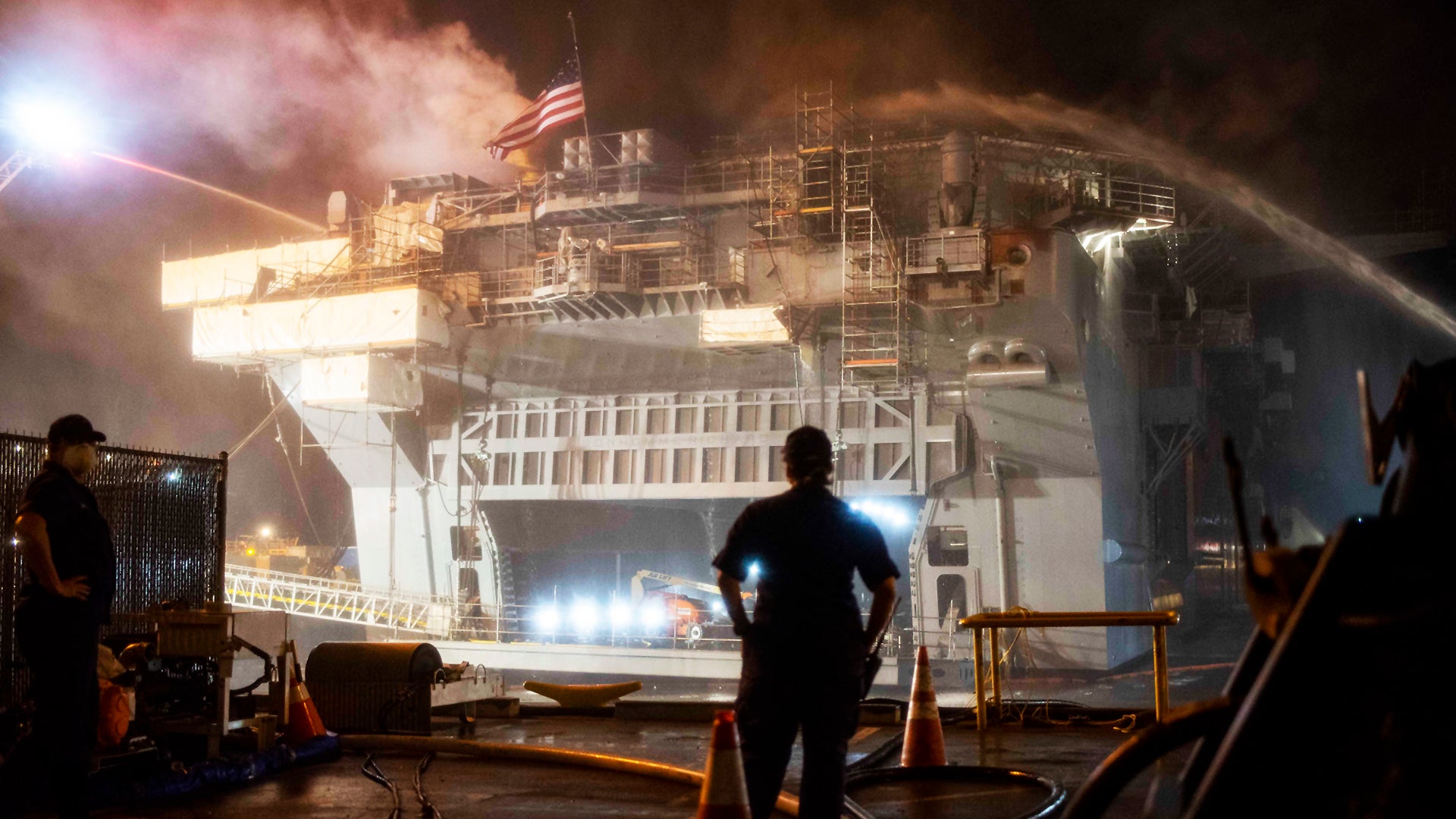Winston
Lorenzo von Matterhorn
- Joined
- Jan 31, 2009
- Messages
- 9,560
- Reaction score
- 1,748
Live feed:
USS Bonhomme Richard on fire at Naval Base San Diego - July 12, 2020
12 Jul 2020
Launched: 14 March 1997
Commissioned: 15 August 1998
Name: Wasp class
Builders: Ingalls Shipbuilding
Operators: United States Navy
Preceded by: Tarawa class
Succeeded by: America class
Cost: Roughly $1.5 billion[1]
In commission: 1989–present
Completed: 8
Active: 8
USS Bonhomme Richard (LHD-6) is a Wasp-class amphibious assault ship, and the third ship of the United States Navy to bear the name. She was named in honor of John Paul Jones' famous frigate, which he had named in French "Good Man Richard," in honor of Benjamin Franklin, the U.S. Ambassador to France at the time; "Richard" is derived from Franklin's Poor Richard's Almanac.
The primary mission of Bonhomme Richard is to embark, deploy and land elements of a Marine landing force in amphibious assault operations by helicopter, landing craft and amphibious vehicle, and if needed, to act as a light aircraft carrier.
Bonhomme Richard is in active service and is the flagship for Expeditionary Strike Group Three.
You always have to wonder if some events might be related...
Are three mysterious explosions in Iran linked? - analysis
Three mysterious incidents, linked by explosions – at least two of them at secretive nuclear and weapons facilities – have rocked Iran in the past week.
JULY 3, 2020
https://www.jpost.com/middle-east/i...ous-explosions-linked-in-iran-analysis-633587
Operation Ababil
https://en.wikipedia.org/wiki/Operation_Ababil
Operation Ababil was a series of cyber attacks starting in 2012, targeting various American financial institutions and carried out by a group calling itself the Cyber fighters of Izz Ad-Din Al Qassam.
The cyber attacks, or more specifically denial of service attacks, were launched by the Cyber fighters of Izz Ad-Din Al Qassam also known as Qassam Cyber Fighters. The group announced the attacks on September 18, 2012 on Pastebin where they criticized Israel and the United States and justified the attacks as a response to the Innocence of Muslims video released by controversial American pastor Terry Jones. Their targets included the New York Stock Exchange as well as a number of banks including J.P. Morgan Chase. The result of the attacks was a limited disruption of the targeted websites. The attacks ended on Oct 23, 2012 because of the Eid al-Adha holiday at which point they offered to speak to the media through e-mail.
On September 21, 2012, the Washington Post reported[4] that the attacks originated not from a hacktivist group but from the government of Iran and cited U.S. Senator Joseph I. Lieberman as one who was a proponent of this idea. Lieberman told C-Span that he believed the Iranian government was sponsoring the group's attacks on US banks in retaliation for Western economic sanctions. An early report by Dancho Danchev found the amateurish "outdated and virtually irrelevant technical skills" of the attack suspicious. But Michael Smith, senior security evangelist at Akamai, found the size of the attacks—65 gigabits of traffic per second—more consistent with a state actor (such as Iran) than with a typical hacktivist denial of service attack which would be less than 2 gigabits/second.
USS Bonhomme Richard on fire at Naval Base San Diego - July 12, 2020
12 Jul 2020
Launched: 14 March 1997
Commissioned: 15 August 1998
Name: Wasp class
Builders: Ingalls Shipbuilding
Operators: United States Navy
Preceded by: Tarawa class
Succeeded by: America class
Cost: Roughly $1.5 billion[1]
In commission: 1989–present
Completed: 8
Active: 8
USS Bonhomme Richard (LHD-6) is a Wasp-class amphibious assault ship, and the third ship of the United States Navy to bear the name. She was named in honor of John Paul Jones' famous frigate, which he had named in French "Good Man Richard," in honor of Benjamin Franklin, the U.S. Ambassador to France at the time; "Richard" is derived from Franklin's Poor Richard's Almanac.
The primary mission of Bonhomme Richard is to embark, deploy and land elements of a Marine landing force in amphibious assault operations by helicopter, landing craft and amphibious vehicle, and if needed, to act as a light aircraft carrier.
Bonhomme Richard is in active service and is the flagship for Expeditionary Strike Group Three.
You always have to wonder if some events might be related...
Are three mysterious explosions in Iran linked? - analysis
Three mysterious incidents, linked by explosions – at least two of them at secretive nuclear and weapons facilities – have rocked Iran in the past week.
JULY 3, 2020
https://www.jpost.com/middle-east/i...ous-explosions-linked-in-iran-analysis-633587
Operation Ababil
https://en.wikipedia.org/wiki/Operation_Ababil
Operation Ababil was a series of cyber attacks starting in 2012, targeting various American financial institutions and carried out by a group calling itself the Cyber fighters of Izz Ad-Din Al Qassam.
The cyber attacks, or more specifically denial of service attacks, were launched by the Cyber fighters of Izz Ad-Din Al Qassam also known as Qassam Cyber Fighters. The group announced the attacks on September 18, 2012 on Pastebin where they criticized Israel and the United States and justified the attacks as a response to the Innocence of Muslims video released by controversial American pastor Terry Jones. Their targets included the New York Stock Exchange as well as a number of banks including J.P. Morgan Chase. The result of the attacks was a limited disruption of the targeted websites. The attacks ended on Oct 23, 2012 because of the Eid al-Adha holiday at which point they offered to speak to the media through e-mail.
On September 21, 2012, the Washington Post reported[4] that the attacks originated not from a hacktivist group but from the government of Iran and cited U.S. Senator Joseph I. Lieberman as one who was a proponent of this idea. Lieberman told C-Span that he believed the Iranian government was sponsoring the group's attacks on US banks in retaliation for Western economic sanctions. An early report by Dancho Danchev found the amateurish "outdated and virtually irrelevant technical skills" of the attack suspicious. But Michael Smith, senior security evangelist at Akamai, found the size of the attacks—65 gigabits of traffic per second—more consistent with a state actor (such as Iran) than with a typical hacktivist denial of service attack which would be less than 2 gigabits/second.







